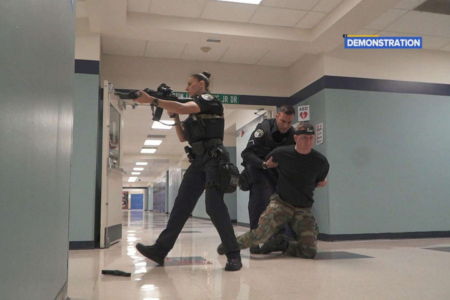Gun lasers, are they a benefit or a hindrance? Lasers are designed for one purpose only…to help the shooter aim faster. Opinions vary on whether or not a laser attached to your gun is helpful. I’m in the “helpful” camp. Let me explain, but I’ll limit the explanation to use on handguns only.
There are four (4) ways lasers are attached to handguns, and I’ll get to the pros and cons of each method of attachment in a bit.
- Rail Lasers. These mount under the muzzle on the Picatinny rail of your gun. If you don’t have a Picatinny rail, you can’t use this kind.
- Trigger Guard Lasers. These are form-fitted lasers which follows the contour of your gun’s trigger guard.
- Grip Lasers. These are replacement or add-on hand-grips with a small laser on top of the grip and the laser on the side of the gun’s frame.
- Slide Spring Lasers. These are actually inside your gun, completely inside the gun’s slide spring, and the laser beam shoots out of a small hole under the muzzle.
Lasers are offered in three (3) beam colors; red, green and blue.
Red lasers are designed for nighttime or dark area use. The effective beam range of red lasers is shorter than green lasers. Battery life is longer on red lasers than on green lasers. Every movie or TV show which has military or law enforcement tangling with bad guys in darkness has the good guys using red lasers aimed at the bad guys’ chest or forehead. Red beam models are very popular among laser users.
Green lasers are designed for anytime use. If you are at an outdoor range in bright sunlight, you will see the beam of a green laser on your brightly lit target, albeit not well. The effective range of green lasers is much longer than red lasers, which makes them ideal for long distance shooting. Because of the electronic design of green lasers and the additional energy consumption, they have a shorter battery life than red lasers, and are susceptible to cold weather reliability. Green lasers are never used in movies and TV because the beam projected onto the bad guys’ chest is not as noticeable on camera, or stated differently, does not provide enough color contrast to be more easily visible to viewers. These are also very popular among shooters, however.
Blue lasers have some of the same characteristics as green lasers in that they are designed for both daytime and nighttime use. The two primary differences are the extended battery life of the blue laser over the green laser, sometimes as much as 4x-5x more, and the in-susceptibility to cold weather. These are not as popular, probably because they are newer and only offered by one company, NC Star, introduced at SHOT Show in 2015. Blue lasers are never used in movies and TV, because the blue color contrast is too dark for the camera to pick up.
There are four (4) major manufacturers of lasers, all of them having products of the different mounting methods described above:
- Crimson Trace
- Viridian
- Lasermax
- Armalaser
Crimson Trace and Viridian are both very popular for their line of trigger guard mounted and grip mounted models. Crimson Trace models feature a small rubber on/off button, similar to a flattened nipple, located on the front of the grip directly under the trigger guard. This requires the shooter to grip the handgun, thereby turning on the laser with the shooter’s middle finger as the fingers squeeze the grip. Viridian models have a small red on/off switch on the side of the laser body. This red switch requires the shooter use their shooting index finger to reach up to the side of the laser and turn the unit on/off.
Lasermax is also very popular but also carries a line of models for slide spring mounting or guide rod replacement. This type of laser is enclosed inside a replacement slide spring. It requires the removal of the slide, the taking out of the factory slide spring and replacing it with this new slide spring containing the laser inside. The on/off switch is now part of the slide take-down lever.
Armalaser is the newest kid on the block of the mainstream laser manufacturers. While Armalaser has been around for years, their entry into gun laser market was behind the others. Their lasers have a full range of mounting choices except for the slide spring/guide rod method.
Pros and Cons of each mounting method.
Rail Lasers:

Pros
- Price – these are relatively inexpensive if you stick to the basic models containing only the laser, regardless of laser color.
- Rail Needed – these models only work if your gun has a Picatinny rail under the muzzle.
- On/Off Switch – these models are turned on and off by extending your trigger finger forward along the slide and pushing a small button on the laser. Some models are ambidextrous so you can do the same with your support hand instead of your shooting hand.
- Sight Adjustments – these models come with windage and elevation adjustment Allen screws so you can fine tune the sight alignment.
- Easily Removed – Can be used on different gun models, simply by loosening the mount screws, removing it from its current gun, placing it on a different gun and tightening the mount screws.
- Options – rail lasers can be combo models, which includes the laser and an LED flashlight, but that also comes with a comparable increase in price. The stronger the LED lumens, the higher the price.
Cons
- Unsightly – Since these models do not follow the contour of your gun, they stick out wider than your gun.
- Dislodging – These models are often held in place on your gun’s rail by a single screw. Because of the extra width of the laser, drawing from and returning to the holster may loosen the laser, (which from personal experience, has happened).
- Manual On/Off Switch – will force shooters to manually turn on the laser prior to engaging a bad guy, which is a deterrent for use in defensive situations. Your goal if you have to use your gun for self-defense is to be able to quickly draw and get your gun on target. Having to remember to turn on the laser slows down the target acquisition time.
- Barrel length – If the barrel is longer than a stretched-out shooting index finger or you have smaller length shooting finger, this will force the shooter to either activate the laser from their support index finger or require the shooter to remove their shooting hand from its native shooting position and move the shooting hand forward to reach the laser’s on/off button.
- Holster Challenges – holster choices are limited when using a laser, unless the holster is specifically made for a laser.
Trigger Guard Lasers:

Pros
- Conforms To Gun’s Contour – Because each laser model is designed around a specific gun model, the laser contour matches that of the gun, specifically the trigger guard.
- Sight Adjustments – All these models come with tiny Allen screws to adjust elevation and windage.
Cons
- On/Off Switch – Depending on the model, the on/off switch may not be easy to use if seconds count in a self-defense situation. This is particularly true of the Crimson Trace models. The aforementioned nipple-type on/off switch on the pistol grip may be easy to turn on if the shooter grips the gun tightly. It is also true of some Viridian models, which have the on/off switch directly at the laser, often red in color.
Grip Lasers

Pros
- Laser Location – The laser sits on the right side of the gun, at the top of the grip. For pistols, the beam shines alongside and parallel to the frame. For revolvers, the beam shines beneath the cylinder and parallel to the frame.
- Adjustment Screws – Elevation and windage adjustments, with small Allen screws.
Cons
- Price – upwards of $200 or more.
- Laser Location – Because the laser sits on the right side of the gun, beneath the slide and parallel to the action, if you are following correct trigger finger discipline, your index finger will be fully extended outside of the trigger guard along the slide, in front of the laser’s beam, thereby preventing the laser beam from hitting your target until you bring your shooting index finger inside the trigger guard to fire.
Slide Spring/Rod Guide Lasers
Pros

- Hidden – will not snag on anything because the laser is completely hidden inside gun
- Holster Choices – Numerous, as there is no need to shop around for laser-specific holsters, as every holster designed for the native model of the gun will work since the laser is completely hidden.
Cons
- Price – These are not cheap, often exceeding $200.
- No Adjustment Screws – because these are hidden completely inside the gun, there are no windage and elevation adjustment screws.
Best laser for new shooters.
The best laser for new shooters, IMHO, is the Armalaser trigger guard red laser, and here is why.

- Since it follows the contour of trigger guard of your gun, the laser does not protrude outside the normal width of your gun.
- Therefore, you do not run the risk of the laser loosening with repeated drawing and re-holstering your gun.
- Red is only needed for nighttime or dark self-defense situations which make acquiring the target difficult by just using the guns sights. If it is daylight or a brightly lit environment, why do you need a green laser, let alone a laser at all? Can’t you simply use your gun’s sights to acquire the target?
- Red lasers are cheaper, by as much as $50 over their green laser counterparts.
- Blue lasers are difficult to find, and Armalaser does not make them.
- Their trigger guard models have a tiny master on/off switch underneath the actual laser, which can be set to “off” for prolonged storage.
- The best part is that the trigger guard models have a set of two tiny parallel electrical contacts directly underneath the trigger guard where the trigger guard meets the grip. The reason is so that the shooter does not have to squeeze the grip in order to turn on the laser, like the Crimson Trace’s “nipple” switch. As the shooter naturally wraps their fingers around the grip, loosely or tightly, the middle finger of the shooting hand merely touching the two electrical contacts is enough to turn it on, which is perfect in a high-stress self-defense situation.
- Made for a wide variety of guns, and not limited to one or two specific brands.
Laser Sighting
The optimal sight placement should be just above the front sight when aiming at a target, say 10 feet away. This will put the front sight at the 6 o’clock position of the target and the laser.
Gun Holsters
Keep in mind that the use of a laser on your gun is going to impact the availability and selection of holsters, regardless of gun model, for the majority of shooters. Every holster manufacturer makes holsters for native models, or better stated, guns without any appliances attached, but only a few of these manufacturers have models designed for guns with attached lasers. Before you decide if you want to use a laser, suggest you scour the internet to see if your favorite holster manufacturer has models designed for lasers, and if so, which specific laser manufacturer it has designed its holsters for, because certain holster manufacturers only design their models for specific laser manufacturers’ products.



